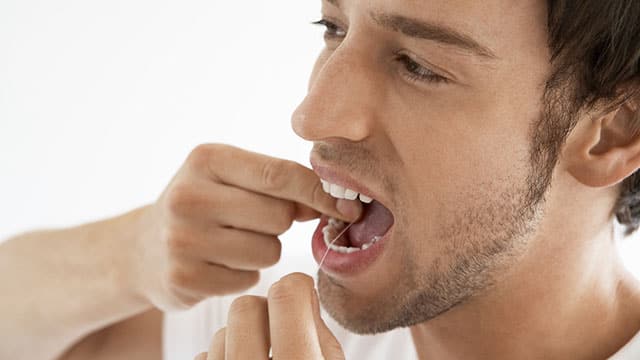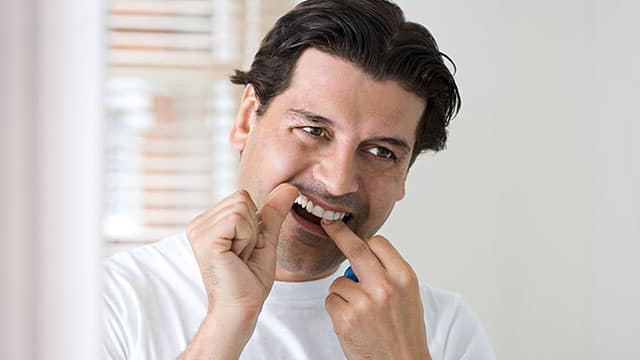Water Flosser Vs. Traditional Floss: A Side-By-Side Comparison
Both water flossers and traditional floss serve the same purpose—interdental cleaning. They remove food particles and plaque between teeth and along the gums. However, each works differently. Water flossing relies on a hand-held device that sprays a jet stream of water for gentle cleaning. Traditional flossing requires a string, with which you can remove plaque manually.
Water flosser: It is a hand-held device that sprays a pressurised stream of fresh water. It removes food debris, plaque and germs from between the teeth and along the gums. Also known as an oral irrigator, it includes a water tank that can be refilled and needs a power source. Most devices come with multiple pressure settings to help you adjust the water jet. The pulsating water stream provides a targeted cleaning that is gentle on your gums.
Traditional flossing: A classic technique that uses a thin string called dental floss. You can slide and move the string between and around your teeth and under the gumline for cleaning. This helps remove plaque and bacteria hiding in areas where a toothbrush cannot reach. Different types of dental floss—waxed, unwaxed, tufted, flavoured or floss holders are available.
Some people ask, “Is water flosser better than floss?” The answer depends on your comfort, lifestyle and dental care needs. Both methods help clean the hard-to-reach areas in your mouth. A water flosser is gentler and comfortable, especially for people with braces or sensitive gums. Traditional floss is effective at removing plaque and is recommended by dentists. Here is a comparison of water flossing vs traditional flossing to help you decide:
Feature | Water Flosser | Traditional Floss |
Cleaning Method | Uses a pressurised water jet to clean between teeth and along the gumline | Uses a string floss to remove plaque between teeth and along the gums manually |
Ease of Use | Easy and convenient for people with dental braces or limited hand movement | Requires more hand coordination |
Effectiveness | Targeted cleaning; reaches tight spaces and removes plaque and bacteria | Removes plaque from between teeth and along the gumline when done correctly |
Comfort | Gentle on the gums, less irritation | May irritate or hurt the gums if not used correctly |
Portability | Bulkier; needs a power source and fresh water to fill the water tank | Light-weight, compact and travel-friendly |
Cost | Costly upfront; price may vary based on variants (such as cordless) | Affordable and widely available |
Maintenance | Requires cleaning and refilling the water tank | No maintenance; disposable after use |
Who Benefits Most From a Water Flosser?
You may wonder “Why use a water flosser or who should consider it over a traditional floss?” Some people may find traditional flossing difficult. They may have limited hand mobility due to health care issues or may be uncomfortable using a string floss. Some may have sensitive, bleeding gums that need gentle care. When considering water flossing vs traditional flossing, people with special oral care needs may prefer water flossing.
A water flosser provides them with a gentler, faster and more convenient alternative. Instead of a string, the jet stream of water cleans between teeth and along the gums. A water flosser offers ease of use, variable pressure and a gentle yet efficient cleaning. These benefits of water flossing are notable for people with:
Braces or dental work: Using a water flosser for braces, dental implants, and bridges can help clean them better. It removes food debris around the brackets and wires, helping prevent plaque buildup.
Sensitive gums: A string floss may irritate sensitive gums if used incorrectly. A water flosser offers a gentle cleaning, helping avoid irritation or bleeding of your gums.
Limited dexterity: A water flosser is a better alternative for those who struggle to use a string dental floss due to mobility issues.
Need for convenience: It is an easier and more convenient tool than a dental floss string. A water flosser can help you build a daily flossing habit.
Can You Use Both Floss and a Water Flosser?
Yes, you may. Flossing with both tools ensures you get the benefits of both. Dental string floss helps remove sticky plaque from between your teeth and under the gumline. The jet stream of a water flosser flushes out food debris and germs. Combining them can keep your teeth and gums extra-clean, especially if you have braces or other dental work.
If you are looking for a water flosser, consider the Colgate Blast Water Flosser. It is a portable flossing device with 3 distinct pressure modes. Gentle, regular and pulse modes cater to diverse preferences for an effective flossing experience. This makes the Colgate water flosser a great choice for people with braces and dental work. Retractable nozzles and up to 60 seconds of water capacity offer an easy, on-the-go use.
You may ask, “Can water flosser replace flossing?” Dentists often suggest using a string dental floss for effective plaque removal. What is more significant is that you floss your teeth daily. Using both methods can double the benefits for a cleaner mouth and good oral health. If you are unsure, consult your dental hygienist for proper guidance.
How to Use Each Tool Correctly
When comparing water flossing vs traditional flossing, some people overlook the flossing technique. Following the correct method is key to getting the best results. With a traditional floss, manually slide the string gently between and around the teeth and under the gumline. With a water flosser, aim the dental water jet between teeth and around the gums for a thorough clean.
Knowing how to use a string floss helps you get the most from it. If done correctly, traditional flossing removes plaque from teeth and under the gumline. This plaque can otherwise harden to tartar, which can only be removed by a dentist. Regular flossing helps prevent tartar and plaque buildup in tight spaces, such as below the gumline. It supports gum health and helps reduce the risk of gum diseases like gingivitis and periodontal disease.
Whether you use a waxed or unwaxed floss, following the right technique matters. It helps you achieve effective cleaning without hurting your teeth and gums in the process. Here is how to do it:
Cut an arm’s length of floss, about 18 inches. Wind most of it around your middle fingers, leaving about 1-2 inches to work with. You may increase the active length for back teeth as needed.
Holding the floss firmly between your index fingers and thumbs, gently slide it between two teeth and move it up and down. Start with the back teeth and work your way forward.
Curve the floss in a C-shape around the base of each tooth and clean beneath the gumline. Make sure to clean the back sides of the molars. Repeat the steps on the opposite tooth.
While flossing the upper teeth, slightly tilt your head downwards and guide the floss gently to the target area. Avoid snapping or forcing the floss to avoid hurting the gum tissues.
Continue until you finish flossing every tooth in your mouth. Use a clean section of the floss as you move from one tooth to another.
If you have any dental work on your teeth, a floss threader can help make regular flossing more hassle-free. Floss threaders are small, flexible plastic tools with loops. They help you guide the floss tape under dental implants, bridges and other tight spaces, where you cannot easily clean manually.
The convenience of water flossing vs traditional flossing makes it preferred by many. No matter the brand or design, using a water flosser correctly helps you benefit the most from it. Whether it is a cordless or a plug-in variant, using the right technique is important for a thorough cleaning of your teeth and gums.
If you are wondering how to use a water flosser, here are some simple steps:
Fill the water tank (reservoir) of the flosser with lukewarm water.
Choose an appropriate floss tip. Water flossers often include multiple tips, like classic jet and orthodontic. Select a tip that is comfortable for you and place it on the handle.
Lean over the sink to avoid splashing. Place the floss tip in the mouth, at a 90-degree angle towards the gumline, and turn the device on.
Start with your back teeth on both the upper and lower jaws and bring the tip forward.
Trace the gumline, pausing briefly between teeth. Ensure contact with the tooth and the gumline.
Floss both the inner and outer surfaces and between teeth. Continue until you finish flossing all your teeth, including the front and back of each tooth.
Once finished, empty the reservoir. Rinse the reservoir, the floss tip, and any removable parts of the device thoroughly, and store the flosser in a neat, dry place.
Interdental cleaning using traditional or water flossing tools is essential to maintain good oral hygiene. Some people consider alternatives, such as interdental brushes with specially designed bristles. No matter the tool, cleaning the hard-to-reach areas in your mouth every day is vital to prevent plaque buildup and oral health issues like bad breath and gum disease.
Understanding water flossing vs traditional flossing helps you set up the best flossing routine for your lifestyle and needs. While water flossing can benefit some people, dentists recommend traditional flossing to manage plaque effectively. Using both can help improve your oral hygiene, paired with daily brushing habits. Good oral care habits and regular dental checkups can help you enjoy a long-lasting, healthy smile.
Frequently Asked Questions
Is a water flosser as good as regular flossing?
Yes, a water flosser can be just as good, particularly for people with dental work, sensitive gums, or difficulty using string floss. It helps them be consistent with the habit of flossing every day.
Can water flossing replace real flossing?
Dentists recommend traditional flossing as it effectively removes plaque from between teeth and along the gumline. However, a water flosser is also effective. Using both can give even better results and extra care for your teeth and gums.
How often should you use a water flosser?
You may use a water flosser once a day, like regular flossing with dental floss. It is an alternative tool for those who find using string floss difficult or have dental appliances or sensitive gums. Combining both is useful for many. What matters most is to floss once daily using the proper technique.
How often should you use a traditional flosser?
Dentists recommend flossing with a traditional string floss once daily. Removing plaque hiding between teeth and in other hard-to-reach areas is vital for good oral health.










